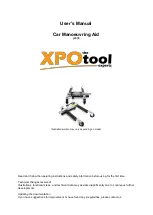
2-2-2 Signal Connections
There are three methods of connecting an oscilloscope to the signal you with to observe,
They are a simple wire lead, coaxial cable, and scope probes.
A simple lead wire may be sufficient when the signal level is high and the source
impedance low (such as TTL circuitry), but is not often used. Unshielded wire picks up
hum and noise ; this tistorts the observed signal when the signal level is low.
Also, there is the problem of making secure mechanical connection to the input
connectors. A binding post-to BNC adapter is adviseable in this case.
Coaxial cable is the most popular method of connecting an oscilloscope to signal
sources and equipment having output connectors. The outer conductor of the cable
shields the central signal conductor from hum and noise pickup. These cables are
usually fitted with BNC connectors on each end, and specialized cable and adaptors are
readily available for matching with other kinds of connectors.
Scope probes are the most popular method of connecting the oscilloscope to circuity.
These probes are available with 1X attenuation (direct connection) and 10X attenuation.
The 10X attenuator probes increase the effective input impedance of the probe/scope
combination to 10 megohms shunted by a few picofarads. The reduction in input
capacitance is the most important reason for using attenuator probes at high frequencies,
where capacitance is the major factor in loading down a circuit and distorting the signal.
When 10X attenuator probes are used, the scale factor (VOLTS/DIV switch setting)
must be multiplied by ten.
Despite their high input impedance, scope probes do not pickup appreciable hum or
noise. As was the case with coaxial cable, the outer conductor of the probe cable shields
the central signal conductor. Scope probes are also quite conven-ient from a mechanical
standpoint.
To determine if a direct connection with shielded cable is permissible, you must know
the source impedance of the circuit you are connecting to, the highest frequencies
involved, and the capacitance of the cable. If any of these factors are unknown, use a
10X low-capacitance probe.
An alternative connection method at high frequencies is terminated coaxial cable.
A feed-thru terminator having an impedance equal to that of the signal-source im-
pedance is connected to the oscilloscope input connector. A coaxial cable of matching
impedance connects the signal source to the terminator.
This technique allows using cables of nearly and practical length without signal loss.
If a low-resistance ground connection between oscilloscope and circuit is not
Free Datasheet http://www.datasheet4u.com/
Содержание OS-5060A
Страница 1: ...Oscilloscope Analog Oscilloscope Operation Manual Free Datasheet http www datasheet4u com ...
Страница 2: ...Oscilloscope Analog Oscilloscope Operation Manual Free Datasheet http www datasheet4u com ...
Страница 13: ...12 Free Datasheet http www datasheet4u com ...
Страница 22: ... a PROBE b EGGECTS OF PROBE COMPENSATION FIGURE 2 2 PROBE COMPENSATION Free Datasheet http www datasheet4u com ...
Страница 27: ...FIGURE 2 3 USING THE TV SYNC SEPARATOR Free Datasheet http www datasheet4u com ...
Страница 30: ...FIGURE 2 4 TRIGGER SLOPE SELECTION Free Datasheet http www datasheet4u com ...
Страница 35: ...FIGURE 2 5 SWEEP MAGNIFICATION BY THE B TIME BASE Free Datasheet http www datasheet4u com ...
Страница 43: ...FIGURE 2 8 TIME INTERVAL MEASUREMENT Free Datasheet http www datasheet4u com ...
Страница 49: ...FIGURE 2 11 RISETIME MEASUREMENT Free Datasheet http www datasheet4u com ...
Страница 51: ...4 DIAGRAMS 4 1 EXTERNAL VIEWS Free Datasheet http www datasheet4u com ...
Страница 52: ...4 2 BLOCK DIAGRAMS Free Datasheet http www datasheet4u com ...
Страница 53: ...The specifications are subjected to change without notice Free Datasheet http www datasheet4u com ...
















































